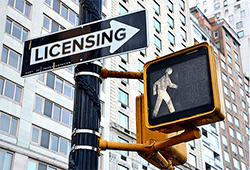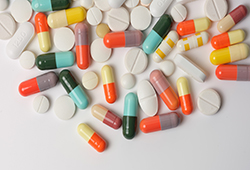“March-In” Rights in the Era of COVID-19: An Unlikely Scenario for Remdesivir

As the total number of COVID-19 deaths in the U.S. is expected to climb to between 180,000 to 200,000 by September 5, 2020[1][2], there currently are no FDA-approved vaccines or drugs to prevent or treat COVID-19. However, the FDA has granted emergency use authorizations to some products for use in certain patients with COVID-19, including to Gilead for its investigational antiviral drug remdesivir[3].
On August 4, 2020, a bipartisan group of 34 state attorneys general (AGs) asked the U.S. government to exercise its march-in rights under the Bayh-Dole Act and license Gilead’s remdesivir to third-party manufacturers in order to scale up production and lower the price of the drug, or allow states to do so.[4] The AGs argued that the U.S. government should exercise its march-in-rights because the price of remdesivir is too high and because Gilead “has benefited from millions of dollars of public funding, including a $30-million NIH-funded clinical trial,” and “is unable to assure a supply of remdesivir sufficient to alleviate the health and safety needs of the country.”[5]
The AGs’ request that the U.S. government exercise its march-in rights under the Bayh-Dole Act, however, does not appear to be tethered to the law.
Under the Bayh-Dole Act, in specific circumstances, the U.S. government has the right to “march-in” and either grant licenses, or require the patent holder/licensee to grant licenses, to third parties under federally funded patents.[6] The U.S. government may exercise its march-in rights if it determines that action is necessary because the patent holder or licensee:
- has not taken, or is not expected to take within a reasonable time, effective steps to achieve practical application of the subject invention;
- is not reasonably satisfying health or safety needs;
- is not reasonably satisfying regulatory requirements for public use; or
- has violated the U.S. industry preference provisions of 35 U.S.C § 204.[7]
If the U.S. government decides to exercise its march-in rights, the decision may be appealed to the U.S. Court of Federal Claims, and with respect to items (1) and (3) above, march-in rights may not be exercised until all appeals or petitions are exhausted.[8]
Despite having the authority, the U.S. government has never exercised its march-in rights. In its response to a 1997 petition requesting that the NIH exercise it march-in rights, the NIH noted its unwillingness “to influence the marketplace for the benefit of a single company, particularly when such actions may have far-reaching repercussions on many companies’ and investors’ future willingness to invest in federally funded medical technologies,”[9] and, with respect to drug pricing, in response to a 2004 petition, the NIH noted that “because the market dynamics for all products developed pursuant to licensing rights under the Bayh-Dole Act could be altered if prices on such products were directed in any way by NIH, the NIH agrees with the public testimony that suggested that the extraordinary remedy of march-in is not an appropriate means of controlling prices.”[10]
Given the fact that: (a) march-in rights are limited to federally funded patented inventions (and it is not clear to what extent federal funds contributed to the development or remdesivir[11]), (b) the Bayh-Dole Act is not triggered by high drug prices, (c) the NIH’s unwillingness to exercise its march-in rights, particularly because it does not want to disincentivize innovation and does not believe that the Bayh-Dole Act should be used to control drug prices, and (d) the patent holder/licensee has the ability to appeal the U.S. government’s decision to exercise its march-in rights, and some instances march-in rights may not be exercised until all appeals or petitions are exhausted, it seems unlikely that the Bayh-Dole Act will be invoked in response to the AGs’ request that the U.S. government exercise its march-in rights.
_______________________________________________________________________________________
[1] According to the Centers for Disease Control and Prevention (CDC) COVID Data Tracker, as of August 21, COVID-19 has claimed 173,490 lives. https://www.cdc.gov/covid-data-tracker/#cases
[2] https://www.cdc.gov/coronavirus/2019-ncov/covid-data/forecasting-us.html#anchor_1587397564229
[3] https://www.gilead.com/purpose/advancing-global-health/covid-19
[4] https://www.oag.ca.gov/system/files/attachments/press-docs/Remdesivir%20Letter%2020200804.pdf
[5] https://www.oag.ca.gov/system/files/attachments/press-docs/Remdesivir%20Letter%2020200804.pdf
[6] 35 U.S.C. §203(a).
[7] 35 U.S.C. §203(a).
[8] 35 U.S.C. §203(b).
[9] Harold Varmus, Director, NIH, Determination in the Case of Petition of CellPro,Inc., August 1, 1997,
[10] Elias A. Zerhouni, Director, NIH, In the Case of Norvir Manufactured by Abbott Laboratories, Inc., July 29, 2004,
http://www.ott.nih.gov/sites/default/files/documents/policy/March-In-Norvir.pdf.
[11] https://www.statnews.com/pharmalot/2020/05/08/gilead-remdesivir-covid19-coronavirus-patents/
 President Trump recently announced four Executive Orders that direct the Secretary of the Department of Health and Human Services (HHS) to implement policy changes to reduce out-of-pocket costs and the price of prescription drugs. All but one of the Executive Orders has been issued with the remaining order on hold until August 24, 2020 pending discussions between the White House and leaders of the pharmaceutical industry. The Executive Orders include some prior policy proposals aimed at lower the cost of drugs and generating savings across the health care system. If implemented, many of these proposals will likely be challenged in court.
President Trump recently announced four Executive Orders that direct the Secretary of the Department of Health and Human Services (HHS) to implement policy changes to reduce out-of-pocket costs and the price of prescription drugs. All but one of the Executive Orders has been issued with the remaining order on hold until August 24, 2020 pending discussions between the White House and leaders of the pharmaceutical industry. The Executive Orders include some prior policy proposals aimed at lower the cost of drugs and generating savings across the health care system. If implemented, many of these proposals will likely be challenged in court.
 Investments in early stage life sciences companies often provide that payments are tranched over time, subject to satisfying agreed milestones. This is normal, but in this abnormal market, stakeholders are approaching tranched investments with more caution.
Investments in early stage life sciences companies often provide that payments are tranched over time, subject to satisfying agreed milestones. This is normal, but in this abnormal market, stakeholders are approaching tranched investments with more caution.